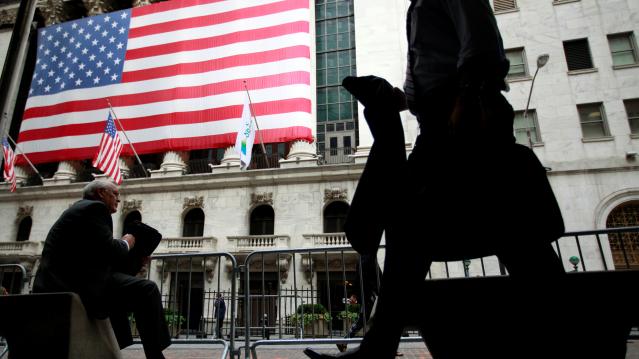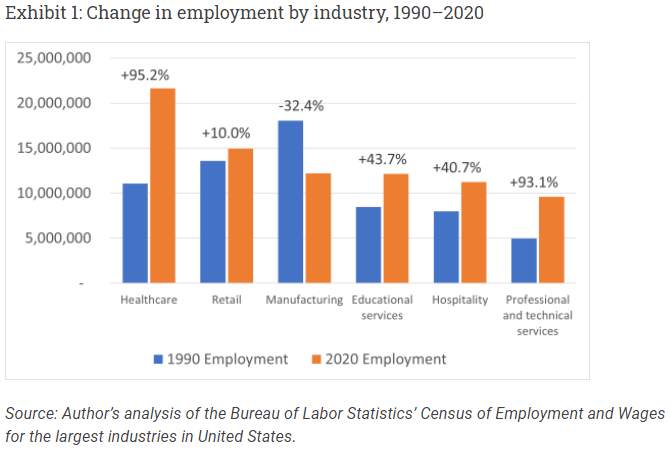
Good Thursday evening. We'll be back in your inbox Tuesday. In the meantime, we wish you a happy and meaningful Memorial Day weekend. Here’s what’s happening on the fiscal front.
First-Quarter GDP Was Even Worse Than Originally Reported. What Comes Next?
The U.S. economy was even weaker in the first three months of 2022 than initially thought, the Bureau of Economic Analysis said Thursday, as it updated its estimate of first-quarter GDP growth to –1.5%, a bit worse than the 1.4% decline that was first reported.
Lower numbers for restocking inventories and residential construction accounted for most of the downward revision, though those were partially offset by an upward revision in consumer spending. Overall, the decline in GDP in the first quarter reflects “decreases in private inventory investment, exports, federal government spending, and state and local government spending,” as well as an increase in imports, the agency said.
The pandemic continued to play a powerfully disruptive role, at a time when many federal aid programs had ended. “In the first quarter, an increase in COVID-19 cases related to the Omicron variant resulted in continued restrictions and disruptions in the operations of establishments in some parts of the country,” the report said. “Government assistance payments in the form of forgivable loans to businesses, grants to state and local governments, and social benefits to households all decreased as provisions of several federal programs expired or tapered off.”
Risks ahead: Most economists expect to see a return to growth in the second quarter, though the economy has been sending some mixed signals lately. Inflation is still running near a 40-year high, and with the Federal Reserve stepping up its effort to bring price increases under control, there are growing concerns that the central bank could push the economy into a recession, led by downturns in the stock and housing markets.
Another concern is stagflation — a mix of high inflation and rising unemployment. Last week, Treasury Secretary Janet Yellen warned that the Russian invasion of Ukraine was increasing the risk of stagflation. “The economic outlook globally,” Yellen said, “is challenging and uncertain, and higher food and energy prices are having stagflationary effects, namely depressing output and spending and raising inflation all around the world.”
Former Fed Chair Ben Bernanke recently said that while the economy is in better shape than it was in the 1970s, when stagflation took hold, the U.S. could be in for a rough ride that echoes that period. “[I]nflation’s still too high but coming down,” he told The New York Times. “So there should be a period in the next year or two where growth is low, unemployment is at least up a little bit and inflation is still high … So you could call that stagflation.”
Still, plenty of analysts say the economy is strong right now and at little risk of falling into recession. Joseph Brusuelas, chief economist at the consulting firm RSM, pushed back against some of the more dire forecasts earlier this week. “There is a 35% probability of a recession over the next 12 months & fears of an imminent recession are overblown,” he wrote.
Pantheon Macro Chief Economist Ian Shepherdson said this week that although he expects the housing market to weaken substantially, that won’t be enough to spark a recession, since the U.S. consumer still has plenty of money, and a decline in housing prices could motivate the Fed to halt its campaign to raise interest rates, reducing deflationary pressure. “The consumer, apart from housing, is charging along,” he told CNBC. “It looks to me like consumption in the 2nd quarter is going to be 4%+, better than the 1st quarter despite soaring gas prices.”
The Coming Budget Squeeze
We told you yesterday about the Congressional Budget Office’s latest update to the federal government’s fiscal outlook, which forecast that the deficit would fall to $1 trillion this year before rising again and that the government’s net interest payments as a share of the economy would jump from 1.6% this year to 3.3% in 2032.
Those rising interest costs will put more of a squeeze on the federal budget, adding to other pressures. Namely, the report also projects that, given the continued aging of the U.S. population and the growth in federal health care costs, outlays for Social Security and Medicare will continue to drive an increase in mandatory spending, with outlays for those two programs rising from 8.2% in 2023 to 10.3% in 2032. Discretionary spending, meanwhile, is projected to grow more slowly than the economy overall, resulting in such spending falling as a percentage of GDP. See the chart below from the Peter G. Peterson Foundation. (The Fiscal Times in an editorially independent organization financed separately by the late Pete Peterson and his family.)
Quote of the Day
“The projection of the cumulative deficit over the 2022–2031 period is $2.4 trillion more than it was last summer. Newly enacted legislation accounts for most of that increase. Other changes that boost projected revenues—and reduce deficits—are mostly offset by economic changes that increase outlays, particularly those for interest and Social Security.”
– Congressional Budget Office Director Phillip Swagel in prepared testimony Thursday before the House Budget Committee on his agency’s latest projections
Why Health Care Reform Is So Hard: ‘People’s Jobs Are at Stake’
One factor that complicates health care reform is often overlooked, David Muhlestein, the chief research and innovation officer at consultancy Health Management Associates, writes in the journal Health Affairs: “People’s jobs are at stake.”
Muhlestein writes that over the last 30 years the health care industry has grown into the nation’s largest by employment — and by 2020 was the largest employer in 47 of 50 states. That growth, he says “leads to increased power in the health care industry’s ability to influence federal policy, including blocking or limiting legislation that may lower health care costs by suggesting that decreased spending will result in fewer jobs. As a result, legislators are reluctant to make policy changes that may reduce jobs when grappling with rising public health care costs. … The size of the industry has then created a powerful messaging platform that can block, slow, or soften congressional attempts to lower health care costs, which results in a form of regulatory capture in which the outcomes benefit the high-cost status quo.”

News
- Biden, First Lady to Travel to Uvalde, Tex., on Sunday – Washington Post
- Senate GOP Blocks Domestic Terrorism Bill as Gun Debate Heats Up – Politico
- First-Quarter GDP Declined 1.5%, Worse Than Thought; Jobless Claims Edge Lower – CNBC
- Democratic Discontent Brews With Federal Reserve – The Hill
- Worry About Stagflation, a Flashback to ’70S, Begins to Grow – Associated Press
- Yellen, Biden's Not-So-Secret Weapon, Sees Clout Diminished – Politico
- US Consumers Expect Inflation Shock to Pass, NY Fed Survey Finds – Bloomberg
- ‘This Is a Crisis Point’: Job Training Deficit Leaves Critical Jobs Unfilled – Politico
- CMS Turning Attention to Hospitals With Covid Outbreaks – Politico
- Britain Announces Tax on Oil and Gas Profits to Fund Cost-Of-Living Payments – New York Times
- CEO Pay Rose 17% In 2021 as Profits Soared; Workers Trailed – Associated Press
- Big Cities Saw Population Declines During Pandemic – Axios
Views and Analysis
- New CBO Report Underscores the Need for a Deficit-Reducing Reconciliation Bill – Ben Ritz, Forbes
- The Fed Is in No Mood to Take a Break on Inflation – Jonathan Levin, Bloomberg
- The Federal Reserve May Have Already Done Enough to Cool the Economy – Ron Insana, CNBC
- Memo to the Fed: Hurry Up and Hike So We Can Slow Down – Daniel Moss, Bloomberg
- It’s Still Covid’s World. We’re Just Living in It – Farhad Manjoo, New York Times
- US Infrastructure Is Nowhere Near Ready for Biden’s Electric Vehicle Timeline – Mark Barrott, The Hill
- Why It’s Hard for the Biden Administration to Figure Out How Much Student Debt to Forgive – Annie Nova, CNBC
- The Globalists at Davos Are Finally Grappling With the Populist Movement – Henry Olsen, Washington Post
- Why, After So Many Mass Shootings, Are We Still Asking the Same Questions? – Washington Post Editorial Board
- These Gun Reforms Could Save 15,000 Lives. We Can Achieve Them – Nicholas Kristof, New York Times
- The Senate Has Forfeited Its Right to Exist – Ryan Cooper, American Prospect
